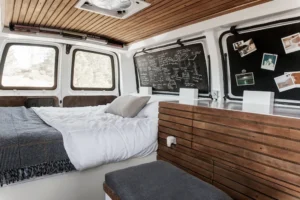In the competitive world of van design, the battle between functionality and aesthetics rages on.
This guide explores the intricate balance between these two aspects in van design. With real-world examples, expert opinions, and industry trends, we shed light on the importance of striking the right balance.
Whether you’re a van manufacturer or a business owner looking to enhance your fleet, this article will provide valuable insights to navigate the functional vs. aesthetic van design dilemma.
Key Takeaways
- Functionality and aesthetics are both important in van design.
- Functional van design focuses on usability and practicality, while aesthetic van design enhances the visual appeal and user experience.
- Finding the right balance between functionality and aesthetics is crucial for impressive and optimal van design.
- Key considerations for functional and aesthetic van design include layout and organization, easy accessibility, durability of materials, technological features, color palette selection, exterior and interior design elements, attention to detail, and incorporation of branding elements.
The Importance of Van Design
When considering the overall design of a van, it is essential to recognize the significance of both functionality and aesthetics.
A well-designed van combines practicality with visual appeal, creating a harmonious balance that enhances the overall experience for its occupants.
Functionality refers to the van’s ability to meet the needs of its users, such as providing ample storage space, efficient use of interior space, and easy access to essential features.
Aesthetics, on the other hand, focuses on the visual aspects of the van, including its exterior design, color scheme, and interior finishes.
Both functionality and aesthetics play a crucial role in attracting customers and creating a sense of belonging.
A van that is visually appealing while also delivering on its intended purpose will not only satisfy its users but also create a positive impression for onlookers.
Understanding Functional Van Design
Functional van design is an integral aspect of creating a well-designed and efficient vehicle. When it comes to vans, functionality goes beyond just the aesthetics and plays a crucial role in determining its usability and practicality.
Understanding functional van design involves considering factors such as storage space, seating arrangement, ease of loading and unloading, accessibility, and overall layout. A well-designed functional van will prioritize functionality without compromising on comfort and safety.
It should be able to accommodate the needs of its users, whether it’s for commercial purposes or personal use. By focusing on the functional aspects of van design, manufacturers can create vehicles that are not only visually appealing but also serve their intended purpose effectively.
Whether it’s maximizing cargo space or providing convenient features, functional van design strives to create a vehicle that meets the practical requirements of its users.

The Impact of Aesthetic Van Design
The aesthetic design of a van can have a significant impact on its overall appeal and user experience. When it comes to van design, aesthetics play a crucial role in attracting potential customers and creating a sense of belonging.
A visually appealing van with sleek lines, modern colors, and eye-catching graphics can instantly capture attention and make a positive impression. Moreover, a well-designed interior with comfortable seating, stylish finishes, and intuitive layout can enhance the overall user experience, making the van more enjoyable and practical to use.
Aesthetics also contribute to the perceived quality and professionalism of a van, which can be essential for businesses that rely on their vehicles for branding and customer interaction.
Finding the Right Balance Between Functionality and Aesthetics
Achieving the ideal balance between functionality and aesthetics is crucial in creating a van design that not only looks impressive but also performs optimally. When it comes to van conversions, functionality refers to the practical aspects of the design that make it efficient and user-friendly. This includes features like storage solutions, seating arrangements, and accessibility.
On the other hand, aesthetics focus on the visual appeal and overall design of the van. While aesthetics are important for creating a visually pleasing space, it is equally important to ensure that the van meets all the functional requirements.
Striking the right balance between functionality and aesthetics requires careful planning and consideration. It involves understanding the needs and preferences of the intended users and incorporating design elements that enhance both the usability and visual appeal of the van.
Key Considerations for Functional Van Design
When designing a functional van, it is essential to carefully consider key elements that contribute to its practicality and user-friendliness. One of the most important considerations is the layout and organization of the van’s interior. Efficient use of space is crucial, with careful placement of storage compartments, seating arrangements, and work areas.
Additionally, the van should be designed with easy accessibility in mind, ensuring that users can easily reach and retrieve items they need. Another key consideration is the durability and strength of the van’s materials and components. Given the van’s intended purpose of transporting goods or equipment, it is important to choose materials that can withstand heavy use and potential wear and tear.
Lastly, the van should be equipped with the necessary technological features, such as GPS navigation systems, safety features, and connectivity options, to enhance functionality and user experience. By carefully considering these key elements, a functional van design can be achieved that meets the needs of its users.
Key Considerations for Aesthetic Van Design
In the realm of van design, careful consideration of aesthetics is crucial to create a visually appealing and captivating vehicle. When designing the aesthetic aspects of a van, there are several key considerations to keep in mind:
- Color palette: Choosing the right colors can greatly impact the overall aesthetic of the van. Consider the brand identity, target audience, and the emotions you want to evoke with the color scheme.
- Exterior design elements: Pay attention to the shape, lines, and overall silhouette of the van. Strive for a design that is sleek, modern, and visually striking.
- Interior layout: The interior design should be both functional and visually pleasing. Think about the placement of windows, lighting, storage options, and overall flow of the space.
Frequently Asked Questions
How Can Van Design Impact the Functionality of the Vehicle?
The functionality of a vehicle can be greatly impacted by its design. Van design plays a crucial role in determining how efficiently the vehicle can be used for its intended purpose.
Factors such as interior layout, storage options, and accessibility features all contribute to the overall functionality of the van.
A well-designed van will prioritize practicality and ease of use, ensuring that users can maximize its capabilities and meet their specific needs.
What Are Some Key Considerations for Achieving a Functional Van Design?
When it comes to achieving a functional van design, there are several key considerations to keep in mind.
First and foremost, the layout and organization of the van’s interior should be optimized for efficiency and ease of use. This involves carefully planning the placement of equipment, storage compartments, and workstations to ensure they are easily accessible and do not obstruct movement within the van.
Additionally, the choice of materials and finishes should prioritize durability and practicality, taking into account factors such as ease of cleaning and resistance to wear and tear.
Can Aesthetic Van Design Negatively Affect the Performance of the Vehicle?
Aesthetic van design can potentially have a negative impact on the performance of the vehicle. While aesthetics are important in creating an appealing and visually pleasing design, they should not compromise the functionality and performance of the van.
Factors such as aerodynamics, weight distribution, and overall balance need to be considered in order to ensure optimal performance. Therefore, it is crucial to strike a balance between aesthetic design and functional considerations to achieve the best possible outcome for the vehicle.
Is It Possible to Find a Perfect Balance Between Functionality and Aesthetics in Van Design?
Finding a perfect balance between functionality and aesthetics in van design is indeed possible.
While functionality focuses on practicality, efficiency, and performance, aesthetics deal with the visual appeal and design elements of a van.
Achieving a harmonious blend of both aspects requires careful consideration of factors such as layout optimization, storage solutions, interior design, and exterior styling.
What Are Some Important Factors to Consider When Focusing on the Aesthetics of a Van Design?
When focusing on the aesthetics of a van design, there are several important factors to consider.
First and foremost is the overall visual appeal of the design. This includes elements such as color, shape, and proportions.
Additionally, attention should be given to the use of materials and finishes, as they can greatly impact the perceived quality and style of the van.
Lastly, considering the target audience and their preferences can also play a significant role in determining the aesthetic direction of the design.
Conclusion
In conclusion, finding the right balance between functionality and aesthetics is crucial in van design. While functionality ensures that the van meets the diverse needs of customers, aesthetics play a significant role in attracting them.
By understanding the importance of van design, considering key factors for both functional and aesthetic aspects, and analyzing real-world examples and industry trends, van manufacturers and customers can make informed decisions.
This guide serves as a valuable resource to navigate the functional vs. aesthetic van design dilemma and enhance fleet designs.
You May Also Like:
